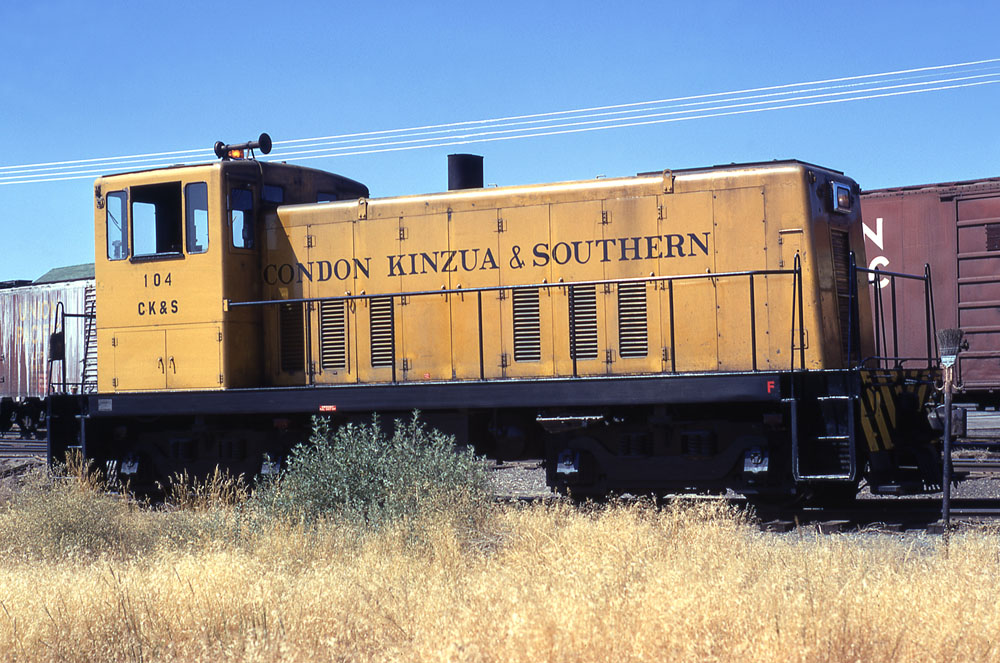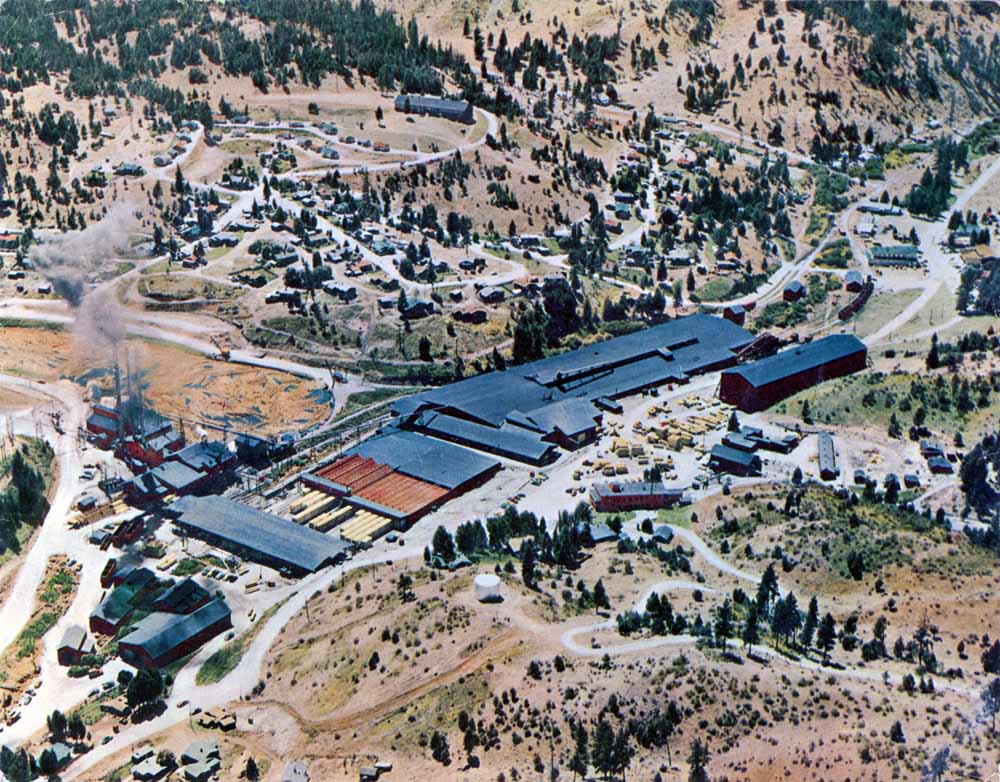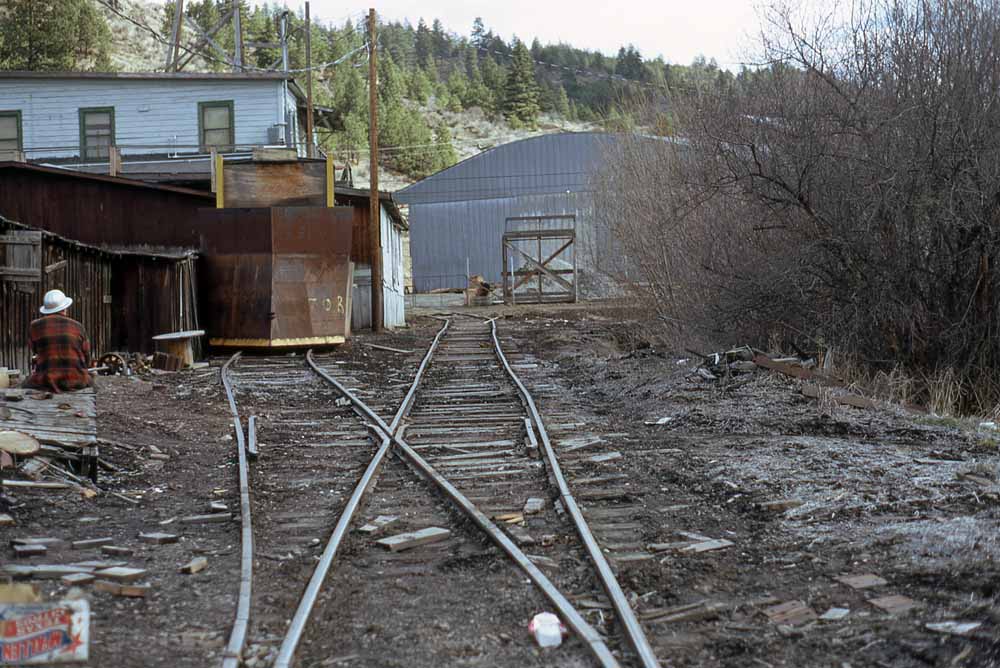|
Condon Kinzua & Southern Railroad Kinzua Pine Mills |
|
|
 |
|
An uncredited photo of Condon Kinzua & Southern General Electric-built 70-ton diesel switcher #104 switching the yard in Condon, Oregon around 1970. |
|
|
History In 1909, a Pennsylvania lumberman named Edward D. Wetmore started buying timberlands in the mountains east of Fossil, Oregon. Continued purchases eventually brought the deeded acreage up to 50,000 acres of prime timber. Mr. Wetmore and his associates did not make any significant moves with his property until 1926, when he toured the pine country between Omak, Washington, and Klamath Falls, Oregon. On his tour Mr. Wetmore "failed to find a plant that was not making money" and was advised by a the President of Portland's Northwest Bank that financial institutions "considered the pine manufacturers good risks and were glad to take their loans". The advise and observations convinced Mr. Wetmore that the time had come to start developing the Oregon properties. He and his associated incorporated the Kinzua Pine Mills company to handle the project. The Kinzua name came from a town on the banks of the Allegheny River in the area of Pennsylvania that Mr. Wetmore hailed from. Kinzua originated from a Senneca tribe term meaning either a place of many fishes or waters of many and big fish, depending on which source you believe. Kinzua Pine Mills initially planned on building a sawmill near the established town of Condon. However, the various elected officials in Condon feared the social impacts that a sawmill might bring to the town. The company then decided to build the sawmill about twenty miles south of Condon, in a small valley near the head of Thirty Mile Creek. The company built a small company town named Kinzua to support the new sawmill. Kinzua Pine Mills decided that the sawmill needed a rail connection to the outside world. By 1927 construction on a 24-mile long railroad had begun. The railroad connected with the end of Union Pacific's Condon branch in Condon and made a short flat run across the agricultural flatlands before decending into Thirty Mile Canyon, which it followed all the way to Kinzua. On 8 May 1928 Kinzua Pine Mills incorporated the Condon, Kinzua & Southern Railroad to operate the Condon-Kinzua trackage as a common carrier. To open the railroad the company purchased a used two-truck Shay type geared locomotive, two flatcars, and a Mack railbus for passenger service. |
|
|
|
|
|
The Kinzua Pine Mill sawmill at Kinzua on a cold February morning in 1957. Photo by and courtesy of Jerry Lamper. |
|
|
 |
|
A postcard aerial view of Kinzua looking generally west across the community. The CK&S main line from Condon is visible entering the frame near the upper right corner. |
|
|
|
The sawmill at Kinzua boomed from the start, with up to 330 people employed at the plant at its peak. In addition to the CK&S, Kinzua Pine Mills operated many miles of private logging railroad to the south and east of Kinzua. The company constructed a total of six log camps to house loggers working in the woods, with one of them (Camp 5) surviving to become the small community of Wetmore. The CK&S served as the link to the outside world for the Kinzua community, and the railroad offered mail and passenger service on a regular basis, using a small self propelled railbus. The Condon Kinzua & Southern initially rostered the two truck Shay already mentioned, with a small Vulcan 0-4-0T added for mill switching duties. In 1936 the operations acquired a three truck Heisler type geared locomotive, with a used three-truck Shay added in 1943. The speed and power of the Heisler over either of the Shays made it the preferred locomotive after it arrived. Typical operations would see one crew use the locomotive on the logging railroad trackage during the day, with a second crew handling the interchange run to Condon each night. Kinzua Pine Mills scrapped the logging railroad lines in favor of truck roads around 1948, which cut the rail operations back to just the CK&S. Further changes came in 1951 when the railroad ended passenger service and purchased a General Electric 70-ton diesel switcher to replace the steam power. The railroad in the later years employed eight people, three on the train crew and five on the section gang that maintained the track structure. The long decline of the railroad started in 1953, when Kinzua Pine Mills started to move their operations eastward with the establishment of a new sawmill complex at Heppner, Oregon. The plant at Kinzua remained active, but was suddenly less important to the parent company. |
|
|
 |
|
CK&S #104 with a train on the line in July 1969. Jeff Moore collection. |
|
|
|
Events started to catch up with the railroad in the mid-1970s. The recession of the period forced Kinzua
Corporation- corporate successor to Kinzua Pine Mills- to close the Kinzua mill for a six week period at one point. Track conditions on the railroad were
getting terrible, with almost the entire line restricted to 10 mile per hour operation or less. Worse yet,
the light rail and sharp curves found on the CK&S proved unable to handle the ever increasing size
and weight of railcars coming into use at the time. Trains continued to run from Kinzua to Condon five days a week,
with the UP running a local down to Condon to effect interchange between the two roads on a three day per week schedule.
UP closed their depot in Condon in November 1975, partially due to the significant drop in carloadings coming off of the
CK&S. The end of the line came in late 1976 after the railroad was cited for fifty eight violations of Federal track standards, with a subsequent order from the Oregon Public Utilities Commission to perform major track upgrades. The remaining life of the Kinzua mill and the revenue potential of the railroad did not justify the costs of performing the required work. On 26 October 1976 Kinzua Corporation issued a notice to all remaining employees on the Condon Kinzua & Southern that rail operations would be terminated as soon as possible. The last revenue train over the line, consisting of three loads of woodchips and four boxcars loaded with lumber, made the trip to Condon on 19 November 1976, and the railroad was done for. |
|
|
 |
|
Part of the Kinzua yard, with the railroad's snowplow on a spur to the left. Jeff Moore collection. |
|
|
|
Operations of the Kinzua mill closed for good shortly after the last train ran, with all operations of the company shifted to the mill in Heppner. The Interstate Commerce Commission granted permission to abandon the Condon, Kinzua & Southern on 14 October 1977, and the rails were removed shortly afterwards. Kinzua became a virtual ghost town by the following year, and by 1979 all buildings in the old town had been either demolished or were destroyed in an arson-caused fire. Following the removal of all buildings the Kinzua Corporation planted 40,000 Ponderosa Pine seedlings in the old townsite. Today little is left at the old site of Kinzua to show the activities that went on there for a half century. Kinzua Corporation continued to operate their mill in Heppner up until the early 1990s, when it too was abandoned following the abandonment of Union Pacific's Heppner branch. Frontier Resources L.L.C. acquired Kinzua Corporation in 1994 and operated a sawmill in Pilot Rock, Oregon, under the Kinzua Resources L.L.C. name until June 2009, when Kinzua sold the mill to timber industry giant Boise-Cascade. The three truck Heisler used on the CK&S/KPM railroads still exists and is operational on the Mt. Rainier Scenic Railroad in Washington, and the railbus (nicknamed the "Goose") that handled the passenger and mail business up until 1951 spent many years on display in Fossil, Oregon, not far removed from the old Kinzua townsite. |
|
|
|
Map  |
|
|
All time locomotive roster Underlined numbers indicate a link to a page of pictures of that locomotive. Condon Kinzua & Southern #1- Lima 2-truck Shay, c/n 3213, built May 1923. Cylinders 11"x12", drivers 32", boiler pressure 200 p.s.i., tractive effort 22,580 lbs., weight of 117,000 lbs. Built as Portland Railway Light & Power Company #3, Estacada, OR; to Portland Electric Power Company #3; to United Commercial Company (Dealer), Portland, Oregon; Leased to Sierra Railway, Oakdale, California (reported here 6 April 1926); to Condon Kinzua & Southern/Kinzua Pine Mills around 1927. Initially #3, later re-numbered to #1. Scrapped sometime after 1947. #104- General Electric 70-ton, 600-horsepower diesel electric, c/n 30845, built March 1951. Purchased new. Sold to St. Regis Paper Company, Libby, Montana, following closure of CK&S; to Champion International #10; to Stimson Timber (all at the same facility in Libby). After the mill closed in 2002, Stimson donated the locomotive to Kootenai River Develompent Council, who re-engined the locomotive with a Cummins engine and GE generator in 2004. At present the locomotive is being used by Revett Minerals to switch a truck-to-rail transload they operate on the old mill site. Kinzua Pine Mills #1- Vulcan 0-4-0T, c/n 3427, built August 1924. Cylinders 11"x16", drivers 30.5", weight 21 tons. Built as Bent Brothers Inc. #1, then to Kinzua Pine Mills. Apparently used as a mill switcher. Scrapped. #3- Lima 3-truck Shay, c/n 3276, built March 1925. Cylinders 12"x15", drivers 36", boiler pressure 200 p.s.i., tractive effort 30,350 lbs., weight 70 tons. Built for Hofius Steel & Equipment (dealer); to Independence Logging #3; to Anderson & Middleton Lumber #3; to Tidewater Timber Company #3; to Kinzua Pine Mills #3 on 7 August 1943. Scrapped after 1951. #102- 3-truck Heisler, c/n 1595, built December 1929. Cylinders 18.25"x16", drivers 40", boiler pressure 200 p.s.i., tractive effort 43,600 lbs., weight 90-tons. Built for stock; Shipped to Whitney Engineering, Tacoma, Washington (Dealer), in May 1930; Sold to Whitney in 1935; to Kinzua Pine Mills 1936. Became primary locomotive on both CK&S and KPM railroads. Only West Coast Special Heisler to ever operate in Oregon. Retired 1951 after the #104 arrived, but retained as backup. Sold to Machinery Sales Company, Portland, Oregon, for $1,000 in August/September 1963; traded to Clyde Schurman for some old mill machinery. Stored at Bridal Vail, Oregon, Banks, Oregon, and Woodland, Washington. Conveyed to Western Washington Forest History Museum on 16 December 1976; to Mt. Rainier Scenic Railroad; to Mt. Rainier Railroad. |
|
|
Gasoline Cars Underlined numbers indicate a link to a page of pictures of that car. #5- Mack railbus, built 1921. Built for the Willamina & Grande Ronde Railroad, where it operated in passenger service up until 1928. Sold to CK&S, where it hauled passengers, mail, and express from then until 1951. Re-built with a new body in the late 1940's. Nicknamed "The Goose" while in service on the CK&S. To Trolleyland Electric Railway Museum, Olympia, WA, sometime after 1951, with the car placed on display in Fossil, OR, for the town's 75th anniversay celebrations. Car displayed in front of the Wheeler County Courthouse in Fossil for many years before ownership ended up in the hands of the Mt. Hood Railroad of Hood River, Oregon. Car passed through the Mt. Rainier Scenic Railroad before being placed on display by the Mt. Hood at Parkdale, OR, under the mistaken belief that the car had once worked on that railroad. Car eventually sold to Willamina Economic Improvement District for $10,000, with the car returned to Willamina by truck in August 2007 for possible restoration and operation in the Willamina area. #7- Skagit Steel & Iron Works model 6-60, c/n 103, blt 1926. Powered with a Buda 105-horsepower engine. Built for Carlisle Lumber Company, Onalaska, WA; to Kinzua Pine Mills #7, Kinzua, OR, 1940; to Condon, Kinzua & Southern Railroad #7. Until recently historians thought the car moved on to the Valley & Siletz Railroad #2, Independence, OR, after the CK&S abandoned, but a recent restoration of that car revealed it was of a different class than this car, indicating this car was likely scrapped along with the rest of the CK&S. |
|
|
Selected Rolling Stock Kinzua Pine Mills Logging Equipment Snowplow Side Dump Hoppers Ballast hopper Flatcar Miscellaneous Maintenance-of-Way |
|
|
Kinzua Pine Mills equipment roster from the October 1937 The Timberman: 1 Class 90 Heisler 1 50-ton Shay 50 Log Cars 14 Great Northern wood flats 14 Union Pacific steel flats 1 American full swing loader 1 Model 74000 Northwest shovel for loading and decking 1 Erie yard shovel 1 Gibson speeder, Ford V-8, motor controls both ends Thank you to John Taubeneck for the information. |
|
|
|
Photos of the Condon Kinzua & Souther/Kinzua Pine Mills Cab Ride by Kieth Ardinger A visit to Kinzua in 1957 by Jerry Lamper Kinzua Today Kinzua Mural in Fossil Kinzua Enginehouse Kinzua Sawmill Trackage in Sawmill CK&S in Condon CK&S in Thirtymile Canyon |
|
|
|
References "Condon Kinzua & Southern, Oregon's now-abandoned lumber-hauling shortline" by Michael R. Polk, November 1978 Pacific RailNews. "Frontier Enterprise versus the Modern Age: Fred Herrick and the Closing of the Lumberman's Frontier" by Thomas R. Cox, January 1993 Pacific Northwest Quarterly. "Stations West, The Story of the Oregon Railways", Edwin D. Culp, Caxton Printers, Caldwell, ID, 1972. Special thanks to John Taubeneck and Martin E. Hansen for additional locomotive and rolling stock roster information. |
|
|
|
More on the Web Some information from these webpages was also used in the creation of this site. Condon Kinzua & Southern Page on Shortline Rosters |
|
|